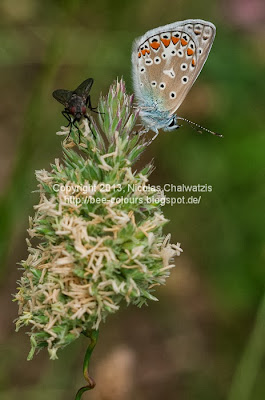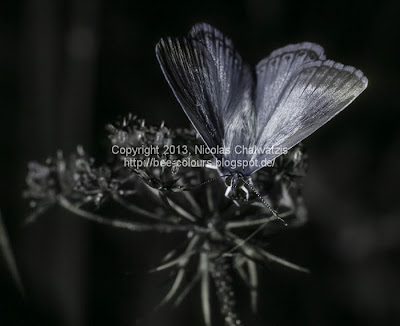Photographed near Burgarach, Southern France 29 July to 8 August 2013.
Polyommatus icarus is one of the most common species
of the family Lycanidae. This species has a Palaearctic distribution. The caterpillars feed
on the various species of Fabacea (e.g. Lotus spp., Lathyrus spp., Trifolium spp., Astragalus spp.).
Similar to the species Polyommatus coridon that was
published here before (http://bee-colours.blogspot.de/2013/09/chalkhill-blue-polyommatus-coridon-poda.html)
the outside or
“downside” of the wings has a UV-reflection that
doesn’t make the animal stand out from the
background. However, in P. icarus the visibly black
and red marks on the wings show a stronger contrast compared to the rest of the wing because they
are entirely UV-black.
The insides, or upper sides, of the wings that are
only visible in active animals and appear to humans in bright blue have a very strong UV-reflexion.
This makes the blue (inner) sides of the wings appear much brighter than the background in the
UV-capture.
UV images were taken with a broadband-modified
Panasonic Lumix G1 and the EL-Nikkor
80mm/f5.6 at f8.
Visible light image: Panasonic Lumix GH2 (unmodified)
with Tokina AT-X 90 mm Macro.
image reference: CHA_P1200160_130731
Visible light image: Panasonic Lumix G1 with EL-Nikkor
80/f5.6, Baader UV/IR-cut-filter:
image reference: CHA_P1100266_130729
UV-image, Baader U-filter 2”, ISO 400, UV-flash MR21N:
image reference: CHA_P1100271_130729
crop from the image above:
UV-image, Baader U-filter 2”, ISO 400, UV-flash MR21N:
image reference: CHA_P1100629_130808









